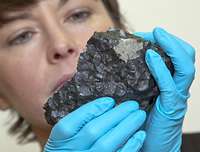Mighty Martian meteorite lands at UK's Natural History Museum

A rare Martian meteorite that could help unravel the mysteries of Mars has arrived at the Natural History Museum in London today, obtained with the support of a donor.
The meteorite is the largest piece from a shower of stones that fell to Earth in Morocco last July, near the village of Tissint. The Tissint meteorite weighs 1.1kg and is now the largest Martian meteorite in the Museum's collections.
"Arguably this is the most important meteorite to have fallen in 100 years and we now have the largest piece in our collections," says Dr Caroline Smith, Museum meteorite expert.
"Martian meteorites are incredibly rare, and when they have been seen to fall and recovered quickly, like Tissint, they offer a unique insight into the Red Planet."
The Tissint meteorite fell in the desert in southern Morocco on 18 July 2012. Witnesses heard 2 sonic booms and saw a bright fireball trace through the night sky.
There have only been 4 other witnessed Martian meteorite falls, the last one in Nigeria in 1962. Just 61 out of the 41,000 meteorites known to science come from Mars, a mere 0.15% of meteorites in collections around the world.
A major problem in studying Martian meteorites is how much the material has become contaminated on Earth, for example from moisture in the air. The longer a meteorite is left before being found, the more contamination is likely.
Caroline adds, "Tissint fell in a dry area, was picked up soon after it fell and has absolutely minimal contamination. It is as if it has just been blasted off Mars."
The acquisition has been made possible through the generous support of a private donor who wishes to remain anonymous. The American and British supporter of the Museum commented, "My family and I are delighted to partner with the Museum in such an important acquisition. We all now set off on an exciting voyage of discovery. Man may not set foot on Mars in the near future, but Mars has come to us. This close-up view will bring new scientific understanding, to spur our children on to further exploration on the surface of the planet itself."
The Museum's collection of about 1,950 individual meteorites is one of the most comprehensive worldwide and Martian meteorites are the most heavily requested by researchers.
Meteorites allow scientists to investigate extraterrestrial material. Studies carried out in the 1970s by Museum scientists showed, for the first time, that water must have existed on Mars – a discovery which was confirmed by later robotic missions to Mars.
Each year about 40,000 to 60,000 tonnes of extraterrestrial material hits Earth, mostly as dust the size of grains of sand.
About 1,000 meteorites land every year ranging from the size of a football to a washing machine. It is very rare to see a meteorite land, but people frequently see meteors falling through the sky, which are often described as shooting stars.
Provided by American Museum of Natural History

















